罗斯 公司理财 英文第九版Chap003PPT课件
《公司理财》斯蒂芬A罗斯英文》PPT课件讲义

5.1 Definition and Example of a Bond
• A bond is a legally binding agreement between a borrower and a lender: – Specifies the principal amount of the loan. – Specifies the size and timing of the cash flows:
• In dollar terms (fixed-rate borrowing) • As a formula (adjustable-rate borrowing)
5.1 Definition and Example of a Bond
• Consider a U.S. government bond listed as 6 3/8 of December 2009.
N I/Y PV PMT FV
12
5
– 1,070.52
31.875 = 1,000
1,000×0.06375 2
5.3 Bond Concepts
1. Bond prices and market interest rates move in opposite directions.
2. When coupon rate = YTM, price = par value. When coupon rate > YTM, price > par value (premium bond) When coupon rate < YTM, price < par value (discount bond)
罗斯公司理财课件

$1,879
$1,742
权益合计 负债和股东权益总计
第二章
财务报表和现金流量
McGraw-Hill/Irwin
Copyright © 2007 by The McGraw-Hill Companies, Inc. All rights reserved.
主要概念和方法
理解财务报表所提供的信息 区分账面和市场价值 辨别平均和边际税率 知道会计利润和现金流量的差别 计算一家企业的现金流量
Copyright © 2007 by The McGraw-Hill Companies, Inc. All rights reserved.
U.S.C.C.损益表
损益表的经营活 动部分报告企业 来自主营业务的 收入和费用。
营业总收入 销货成本 销售、行政和管理费用 折旧 营业利润 其他收入 息前税前利润 利息费用 税前利润 所得税 当前:$71 递延:$13 净利润 留存收益增加 股利 $2,262 1,655 327 90 $190 29 $219 49 $170 84
$1,879
$1,742
Copyright © 2007 by The McGraw-Hill Companies, Inc. All rights reserved.
资产负债表分析
当分析一张资产负债表时,财务经理应留 意三个要点:
1. 2. 3.
会计流动性 负债与权益 市价与成本
McGraw-Hill/Irwin
McGraw-Hill/Irwin Copyright © 2007 by The McGraw-Hill Companies, Inc. All rights reserved.
罗斯《公司理财》第9版英文原书课后部分章节答案
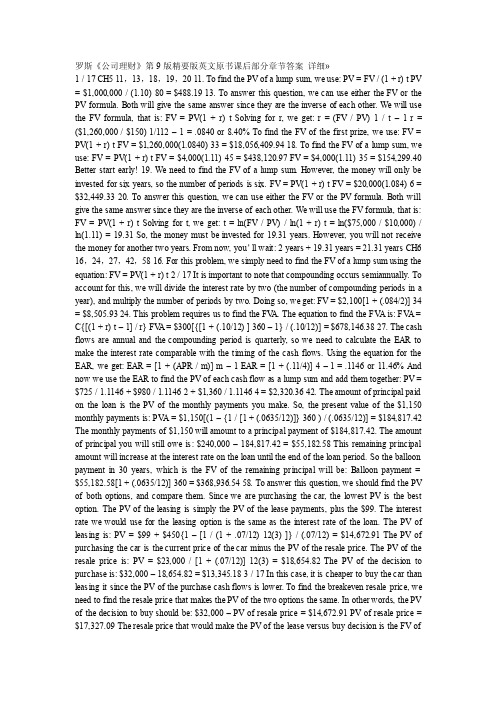
罗斯《公司理财》第9版精要版英文原书课后部分章节答案详细»1 / 17 CH5 11,13,18,19,20 11. To find the PV of a lump sum, we use: PV = FV / (1 + r) t PV = $1,000,000 / (1.10) 80 = $488.19 13. To answer this question, we can use either the FV or the PV formula. Both will give the same answer since they are the inverse of each other. We will use the FV formula, that is: FV = PV(1 + r) t Solving for r, we get: r = (FV / PV) 1 / t –1 r = ($1,260,000 / $150) 1/112 – 1 = .0840 or 8.40% To find the FV of the first prize, we use: FV = PV(1 + r) t FV = $1,260,000(1.0840) 33 = $18,056,409.94 18. To find the FV of a lump sum, we use: FV = PV(1 + r) t FV = $4,000(1.11) 45 = $438,120.97 FV = $4,000(1.11) 35 = $154,299.40 Better start early! 19. We need to find the FV of a lump sum. However, the money will only be invested for six years, so the number of periods is six. FV = PV(1 + r) t FV = $20,000(1.084)6 = $32,449.33 20. To answer this question, we can use either the FV or the PV formula. Both will give the same answer since they are the inverse of each other. We will use the FV formula, that is: FV = PV(1 + r) t Solving for t, we get: t = ln(FV / PV) / ln(1 + r) t = ln($75,000 / $10,000) / ln(1.11) = 19.31 So, the money must be invested for 19.31 years. However, you will not receive the money for another two years. From now, you’ll wait: 2 years + 19.31 years = 21.31 years CH6 16,24,27,42,58 16. For this problem, we simply need to find the FV of a lump sum using the equation: FV = PV(1 + r) t 2 / 17 It is important to note that compounding occurs semiannually. To account for this, we will divide the interest rate by two (the number of compounding periods in a year), and multiply the number of periods by two. Doing so, we get: FV = $2,100[1 + (.084/2)] 34 = $8,505.93 24. This problem requires us to find the FV A. The equation to find the FV A is: FV A = C{[(1 + r) t – 1] / r} FV A = $300[{[1 + (.10/12) ] 360 – 1} / (.10/12)] = $678,146.38 27. The cash flows are annual and the compounding period is quarterly, so we need to calculate the EAR to make the interest rate comparable with the timing of the cash flows. Using the equation for the EAR, we get: EAR = [1 + (APR / m)] m – 1 EAR = [1 + (.11/4)] 4 – 1 = .1146 or 11.46% And now we use the EAR to find the PV of each cash flow as a lump sum and add them together: PV = $725 / 1.1146 + $980 / 1.1146 2 + $1,360 / 1.1146 4 = $2,320.36 42. The amount of principal paid on the loan is the PV of the monthly payments you make. So, the present value of the $1,150 monthly payments is: PV A = $1,150[(1 – {1 / [1 + (.0635/12)]} 360 ) / (.0635/12)] = $184,817.42 The monthly payments of $1,150 will amount to a principal payment of $184,817.42. The amount of principal you will still owe is: $240,000 – 184,817.42 = $55,182.58 This remaining principal amount will increase at the interest rate on the loan until the end of the loan period. So the balloon payment in 30 years, which is the FV of the remaining principal will be: Balloon payment = $55,182.58[1 + (.0635/12)] 360 = $368,936.54 58. To answer this question, we should find the PV of both options, and compare them. Since we are purchasing the car, the lowest PV is the best option. The PV of the leasing is simply the PV of the lease payments, plus the $99. The interest rate we would use for the leasing option is the same as the interest rate of the loan. The PV of leasing is: PV = $99 + $450{1 –[1 / (1 + .07/12) 12(3) ]} / (.07/12) = $14,672.91 The PV of purchasing the car is the current price of the car minus the PV of the resale price. The PV of the resale price is: PV = $23,000 / [1 + (.07/12)] 12(3) = $18,654.82 The PV of the decision to purchase is: $32,000 – 18,654.82 = $13,345.18 3 / 17 In this case, it is cheaper to buy the car than leasing it since the PV of the purchase cash flows is lower. To find the breakeven resale price, we need to find the resale price that makes the PV of the two options the same. In other words, the PV of the decision to buy should be: $32,000 – PV of resale price = $14,672.91 PV of resale price = $17,327.09 The resale price that would make the PV of the lease versus buy decision is the FV ofthis value, so: Breakeven resale price = $17,327.09[1 + (.07/12)] 12(3) = $21,363.01 CH7 3,18,21,22,31 3. The price of any bond is the PV of the interest payment, plus the PV of the par value. Notice this problem assumes an annual coupon. The price of the bond will be: P = $75({1 – [1/(1 + .0875)] 10 } / .0875) + $1,000[1 / (1 + .0875) 10 ] = $918.89 We would like to introduce shorthand notation here. Rather than write (or type, as the case may be) the entire equation for the PV of a lump sum, or the PV A equation, it is common to abbreviate the equations as: PVIF R,t = 1 / (1 + r) t which stands for Present V alue Interest Factor PVIFA R,t = ({1 – [1/(1 + r)] t } / r ) which stands for Present V alue Interest Factor of an Annuity These abbreviations are short hand notation for the equations in which the interest rate and the number of periods are substituted into the equation and solved. We will use this shorthand notation in remainder of the solutions key. 18. The bond price equation for this bond is: P 0 = $1,068 = $46(PVIFA R%,18 ) + $1,000(PVIF R%,18 ) Using a spreadsheet, financial calculator, or trial and error we find: R = 4.06% This is thesemiannual interest rate, so the YTM is: YTM = 2 4.06% = 8.12% The current yield is:Current yield = Annual coupon payment / Price = $92 / $1,068 = .0861 or 8.61% The effective annual yield is the same as the EAR, so using the EAR equation from the previous chapter: Effective annual yield = (1 + 0.0406) 2 – 1 = .0829 or 8.29% 20. Accrued interest is the coupon payment for the period times the fraction of the period that has passed since the last coupon payment. Since we have a semiannual coupon bond, the coupon payment per six months is one-half of the annual coupon payment. There are four months until the next coupon payment, so two months have passed since the last coupon payment. The accrued interest for the bond is: Accrued interest = $74/2 × 2/6 = $12.33 And we calculate the clean price as: 4 / 17 Clean price = Dirty price –Accrued interest = $968 –12.33 = $955.67 21. Accrued interest is the coupon payment for the period times the fraction of the period that has passed since the last coupon payment. Since we have a semiannual coupon bond, the coupon payment per six months is one-half of the annual coupon payment. There are two months until the next coupon payment, so four months have passed since the last coupon payment. The accrued interest for the bond is: Accrued interest = $68/2 × 4/6 = $22.67 And we calculate the dirty price as: Dirty price = Clean price + Accrued interest = $1,073 + 22.67 = $1,095.67 22. To find the number of years to maturity for the bond, we need to find the price of the bond. Since we already have the coupon rate, we can use the bond price equation, and solve for the number of years to maturity. We are given the current yield of the bond, so we can calculate the price as: Current yield = .0755 = $80/P 0 P 0 = $80/.0755 = $1,059.60 Now that we have the price of the bond, the bond price equation is: P = $1,059.60 = $80[(1 – (1/1.072) t ) / .072 ] + $1,000/1.072 t We can solve this equation for t as follows: $1,059.60(1.072) t = $1,111.11(1.072) t –1,111.11 + 1,000 111.11 = 51.51(1.072) t2.1570 = 1.072 t t = log 2.1570 / log 1.072 = 11.06 11 years The bond has 11 years to maturity.31. The price of any bond (or financial instrument) is the PV of the future cash flows. Even though Bond M makes different coupons payments, to find the price of the bond, we just find the PV of the cash flows. The PV of the cash flows for Bond M is: P M = $1,100(PVIFA 3.5%,16 )(PVIF 3.5%,12 ) + $1,400(PVIFA3.5%,12 )(PVIF 3.5%,28 ) + $20,000(PVIF 3.5%,40 ) P M = $19,018.78 Notice that for the coupon payments of $1,400, we found the PV A for the coupon payments, and then discounted the lump sum back to today. Bond N is a zero coupon bond with a $20,000 par value, therefore, the price of the bond is the PV of the par, or: P N = $20,000(PVIF3.5%,40 ) = $5,051.45 CH8 4,18,20,22,244. Using the constant growth model, we find the price of the stock today is: P 0 = D 1 / (R – g) = $3.04 / (.11 – .038) = $42.22 5 / 17 18. The price of a share of preferred stock is the dividend payment divided by the required return. We know the dividend payment in Year 20, so we can find the price of the stock in Y ear 19, one year before the first dividend payment. Doing so, we get: P 19 = $20.00 / .064 P 19 = $312.50 The price of the stock today is the PV of the stock price in the future, so the price today will be: P 0 = $312.50 / (1.064) 19 P 0 = $96.15 20. We can use the two-stage dividend growth model for this problem, which is: P 0 = [D 0 (1 + g 1 )/(R – g 1 )]{1 – [(1 + g 1 )/(1 + R)] T }+ [(1 + g 1 )/(1 + R)] T [D 0 (1 + g 2 )/(R –g 2 )] P0 = [$1.25(1.28)/(.13 –.28)][1 –(1.28/1.13) 8 ] + [(1.28)/(1.13)] 8 [$1.25(1.06)/(.13 – .06)] P 0 = $69.55 22. We are asked to find the dividend yield and capital gains yield for each of the stocks. All of the stocks have a 15 percent required return, which is the sum of the dividend yield and the capital gains yield. To find the components of the total return, we need to find the stock price for each stock. Using this stock price and the dividend, we can calculate the dividend yield. The capital gains yield for the stock will be the total return (required return) minus the dividend yield. W: P 0 = D 0 (1 + g) / (R – g) = $4.50(1.10)/(.19 – .10) = $55.00 Dividend yield = D 1 /P 0 = $4.50(1.10)/$55.00 = .09 or 9% Capital gains yield = .19 – .09 = .10 or 10% X: P 0 = D 0 (1 + g) / (R – g) = $4.50/(.19 – 0) = $23.68 Dividend yield = D 1 /P 0 = $4.50/$23.68 = .19 or 19% Capital gains yield = .19 – .19 = 0% Y: P 0 = D 0 (1 + g) / (R – g) = $4.50(1 – .05)/(.19 + .05) = $17.81 Dividend yield = D 1 /P 0 = $4.50(0.95)/$17.81 = .24 or 24% Capital gains yield = .19 – .24 = –.05 or –5% Z: P 2 = D 2 (1 + g) / (R – g) = D 0 (1 + g 1 ) 2 (1 +g 2 )/(R – g 2 ) = $4.50(1.20) 2 (1.12)/(.19 – .12) = $103.68 P 0 = $4.50 (1.20) / (1.19) + $4.50(1.20) 2 / (1.19) 2 + $103.68 / (1.19) 2 = $82.33 Dividend yield = D 1 /P 0 = $4.50(1.20)/$82.33 = .066 or 6.6% Capital gains yield = .19 – .066 = .124 or 12.4% In all cases, the required return is 19%, but the return is distributed differently between current income and capital gains. High growth stocks have an appreciable capital gains component but a relatively small current income yield; conversely, mature, negative-growth stocks provide a high current income but also price depreciation over time. 24. Here we have a stock with supernormal growth, but the dividend growth changes every year for the first four years. We can find the price of the stock in Y ear 3 since the dividend growth rate is constant after the third dividend. The price of the stock in Y ear 3 will be the dividend in Y ear 4, divided by the required return minus the constant dividend growth rate. So, the price in Y ear 3 will be: 6 / 17 P3 = $2.45(1.20)(1.15)(1.10)(1.05) / (.11 – .05) = $65.08 The price of the stock today will be the PV of the first three dividends, plus the PV of the stock price in Y ear 3, so: P 0 = $2.45(1.20)/(1.11) + $2.45(1.20)(1.15)/1.11 2 + $2.45(1.20)(1.15)(1.10)/1.11 3 + $65.08/1.11 3 P 0 = $55.70 CH9 3,4,6,9,15 3. Project A has cash flows of $19,000 in Y ear 1, so the cash flows are short by $21,000 of recapturing the initial investment, so the payback for Project A is: Payback = 1 + ($21,000 / $25,000) = 1.84 years Project B has cash flows of: Cash flows = $14,000 + 17,000 + 24,000 = $55,000 during this first three years. The cash flows are still short by $5,000 of recapturing the initial investment, so the payback for Project B is: B: Payback = 3 + ($5,000 / $270,000) = 3.019 years Using the payback criterion and a cutoff of 3 years, accept project A and reject project B. 4. When we use discounted payback, we need to find the value of all cash flows today. The value today of the project cash flows for the first four years is: V alue today of Y ear 1 cash flow = $4,200/1.14 = $3,684.21 V alue today of Y ear 2 cash flow = $5,300/1.14 2 = $4,078.18 V alue today of Y ear 3 cash flow = $6,100/1.14 3 = $4,117.33 V alue today of Y ear 4 cash flow = $7,400/1.14 4 = $4,381.39 To findthe discounted payback, we use these values to find the payback period. The discounted first year cash flow is $3,684.21, so the discounted payback for a $7,000 initial cost is: Discounted payback = 1 + ($7,000 – 3,684.21)/$4,078.18 = 1.81 years For an initial cost of $10,000, the discounted payback is: Discounted payback = 2 + ($10,000 –3,684.21 –4,078.18)/$4,117.33 = 2.54 years Notice the calculation of discounted payback. We know the payback period is between two and three years, so we subtract the discounted values of the Y ear 1 and Y ear 2 cash flows from the initial cost. This is the numerator, which is the discounted amount we still need to make to recover our initial investment. We divide this amount by the discounted amount we will earn in Y ear 3 to get the fractional portion of the discounted payback. If the initial cost is $13,000, the discounted payback is: Discounted payback = 3 + ($13,000 – 3,684.21 – 4,078.18 – 4,117.33) / $4,381.39 = 3.26 years 7 / 17 6. Our definition of AAR is the average net income divided by the average book value. The average net income for this project is: A verage net income = ($1,938,200 + 2,201,600 + 1,876,000 + 1,329,500) / 4 = $1,836,325 And the average book value is: A verage book value = ($15,000,000 + 0) / 2 = $7,500,000 So, the AAR for this project is: AAR = A verage net income / A verage book value = $1,836,325 / $7,500,000 = .2448 or 24.48% 9. The NPV of a project is the PV of the outflows minus the PV of the inflows. Since the cash inflows are an annuity, the equation for the NPV of this project at an 8 percent required return is: NPV = –$138,000 + $28,500(PVIFA 8%, 9 ) = $40,036.31 At an 8 percent required return, the NPV is positive, so we would accept the project. The equation for the NPV of the project at a 20 percent required return is: NPV = –$138,000 + $28,500(PVIFA 20%, 9 ) = –$23,117.45 At a 20 percent required return, the NPV is negative, so we would reject the project. We would be indifferent to the project if the required return was equal to the IRR of the project, since at that required return the NPV is zero. The IRR of the project is: 0 = –$138,000 + $28,500(PVIFA IRR, 9 ) IRR = 14.59% 15. The profitability index is defined as the PV of the cash inflows divided by the PV of the cash outflows. The equation for the profitability index at a required return of 10 percent is: PI = [$7,300/1.1 + $6,900/1.1 2 + $5,700/1.1 3 ] / $14,000 = 1.187 The equation for the profitability index at a required return of 15 percent is: PI = [$7,300/1.15 + $6,900/1.15 2 + $5,700/1.15 3 ] / $14,000 = 1.094 The equation for the profitability index at a required return of 22 percent is: PI = [$7,300/1.22 + $6,900/1.22 2 + $5,700/1.22 3 ] / $14,000 = 0.983 8 / 17 We would accept the project if the required return were 10 percent or 15 percent since the PI is greater than one. We would reject the project if the required return were 22 percent since the PI。
公司理财罗斯(课堂PPT)
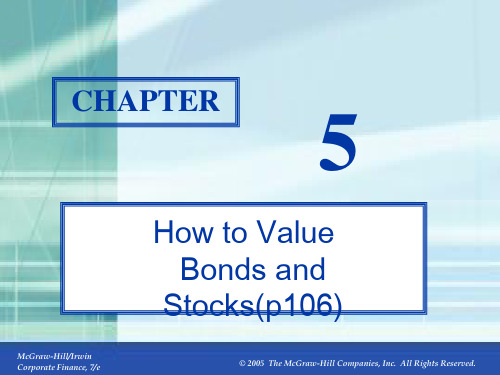
McGraw-Hill/Irwin Corporate Finance, 7/e
© 2005 The McGraw-Hill Companies, Inc. All Rights Reserved.
5-4
5.1 Definition and Example of a Bond
Consider a U.S. government bond listed as 6 3/8 of December 2009.
Time to maturity (T) = Maturity date - today’s date Face value (F) Discount rate (r)
$0
$0
$0
$F
0
1
2
T 1
T
Present value of a pure discount bond at time 0:
PV
F (1 r)T
McGraw-Hill/Irwin Corporate Finance, 7/e
© 2005 The McGraw-Hill Companies, Inc. All Rights Reserved.
5-9
Pure Discount Bonds: Example
Find the value of a 30-year zero-coupon bond with a $1,000 par value and a YTM of 6%.
McGraw-Hill/Irwin Corporate Finance, 7/e
© 2005 The McGraw-Hill Companies, Inc. All Rights Reserved.
5-8
罗斯公司理财ppt课件
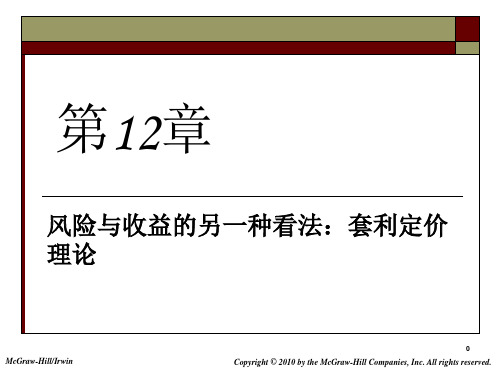
虑从历史数据中去寻找规律和关系。 但要注意,相关并不表示存在因果关系。 实证研究方法需要将投资组合按风格进行
分类,例如:
价值投资组合 增长水平投资组合
24
12-24
快速测试
区分系统性风险与非系统性风险。哪种风 险在多元化的投资组合中可能被有效地分 散掉?
风险就相当于只剩下有系统性风险了。
4
12-4
系统性风险与非系统性风险
持有股票投资的总风险可被分解为两个部分:系统 性风险和非系统性风险:
2
总风险
非系统性风险:
系统性风险: m
由R R U ,可有
R Rmε 其中 : m 表示系统性风险 ε 表示非系统性风险
5
n
12-5
12.2 系统性风险与贝塔系数
由于并不需要占用任何投资,投资者能 通常持有大量头寸来赚得巨额的利润。
在有效的市场中,能赚钱的套利机会往 往很快就会消失。
3
12-3
总风险
总风险 = 系统性风险+ 非系统性风险 收益的标准差衡量的总风险的大小 对风险分散效果好的投资组合来说,非系
统性风险已经微乎其微了。 因此,对风险分散效果好的组合来说,总
2. bGNP = 1.50
3. bS = 0.50
最后,公司能吸引到一位“超级明星” CEO,
这一未预计到的好事将使公司的股票收益增
加 1%。则:
ε 1%
R R - 2.30 FI 1.50 FGNP 0.50 FS 1%
8
12-8
例:系统性风险与贝塔系数
R R - 2.30 FI 1.50 FGNP 0.50 FS 1% 然后,我们必须判断有哪些系统性风险因素的意
罗斯公司理财PPT第3章
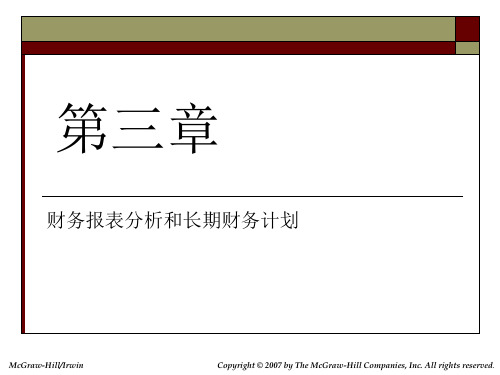
二 长期偿债能力分析
总负债比率 权益乘数 利息倍数 现金保障倍数
McGraw-Hill/Irwin
Copyright © 2007 by The McGraw-Hill Companies, Inc. All rights reserved.
二 长期偿债能力分析
长期偿债能力高低取决于: (1)资金结构的合理性和稳定性; (2)长期盈利能力的高低 企业资金的不同来源及其比例关系——数据来自于资 产负债表 盈利能力——数据来自于利润表
McGraw-Hill/Irwin
Copyright © 2007 by The McGraw-Hill Companies, Inc. All rights reserved.
财务比率分类
短期偿债能力或流动性比率 长期偿债能力或财务杠杆比率 资产管理或周转比率 获利能力比率 市场价值比率
McGraw-Hill/Irwin
Copyright © 2007 by The McGraw-Hill Companies, Inc. All rights reserved.
计算存货比率
存货周转率 = 销货成本 / 存货
1344 / 422 = 3.2 次 365 / 3.2 = 114 天
计算保障倍数比率
利息倍数 = EBIT / 利息
利息倍数至少应当大于1 691 / 141 = 4.9 倍
现金保障倍数 = (EBIT + 折旧) / 利息
(691 + 276) / 141 = 6.9 倍
McGraw-Hill/Irwin
Copyright © 2007 by The McGraw-Hill Companies, Inc. All rights reserved.
公司理财罗斯英文原书第九版第一章课件

How should short-term assets be managed and financed?
公司理财罗斯英文原书第九版第一章
Current Liabilities Long-Term
Debt
Shareholders’ Equity
The Financial Manager
The Financial Manager’s primary goal is to increase the value of the firm by: 1. Selecting value creating projects 2. Making smart financing decisions
Know the goal of financial management Understand the conflicts of interest that can arise between
owners and managers Understand the various regulations that firms face
Current Assets
Current Liabilities
Long-Term Debt
Fixed Assets 1 Tangible 2 Intangible
What longterm investments should the firm choose?
公司理财罗斯英文原书第九版第一章
Shareholders’ Equity
Know the basic types of financial management decisions and the role of the Financial Manager
《公司理财》斯蒂芬A.罗斯..,机械工业出版社 英文课件

McGraw-Hill/Irwin
Copyright © 2004 by The McGraw-Hill Companies, Inc. All rights reserved.
5-7
Pure Discount Bonds
Information needed for valuing pure discount bonds:
5-6
5.2 How to Value Bonds
• Identify the size and timing of cash flows. • Discount at the correct discount rate.
– If you know the price of a bond and the size and timing of cash flows, the yield to maturity is the discount rate.
– Time to maturity (T) = Maturity date - today’s date – Face value (F) – Discount rate (r)
$0
0
$0
$0
T 1
$F
T
1
2
Present value of a pure discount bond at time 0:
• To value bonds and stocks we need to:
– Estimate future cash flows:
• Size (how much)ຫໍສະໝຸດ and • Timing (when)
– Discount future cash flows at an appropriate rate:
罗斯公司理财英文第九版Chap005ppt课件
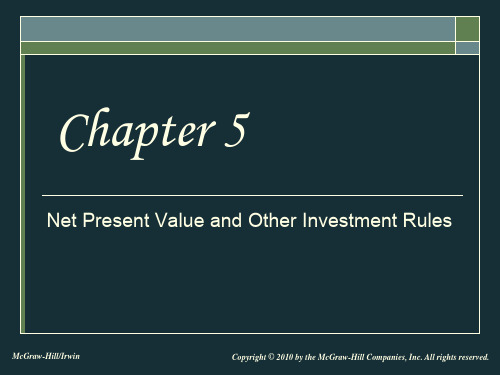
($49.54)
40%
($58.60) ($100.00)
44%
($66.82)
Discount rate
5-12
Calculating IRR with Spreadsheets
You start with the same cash flows as you did for the NPV.
Using the NPV function:
The first component is the required return entered as a decimal.
The second component is the range of cash flows beginning with year 1.
normally want to increase the decimal places to at least two.
5-13
5.5 Problems with IRR
Multiple IRRs Are We Borrowing or Lending The Scale Problem The Timing Problem
You use the IRR function:
You first enter your range of cash flows, beginning with the initial cash flow.
You can enter a guess, but it is not necessary. The default format is a whole percent – you will
Add the initial investment after computing the NPV.
罗斯公司理财PPT课件

1.4421 (1.095844)4
第20页/共24页
例:几何收益率
• 注意:几何平均数与代数平均数是不
同的:
年 收益率1 10%Fra bibliotek2 -5% 3 20% 4 15%
代数平均收益率 R1 R2 R3 R4 4
第23页/共24页
感谢您的观看!
第24页/共24页
方差
.002025 .000225 .002025 .000225 .0045
方差 = .0045 / (4-1) = .0015 标准差 = .03873
第18页/共24页
10.6 关于平均收益率的更多讨论
• 代数平均值 – 在多期中,平均每期所赚的收益率 • 几何平均值 – 在多期中,平均每期按复利计算的收益率 • 除非各期的收益率都相等,否则几何收益率通常都低于代数收
风险报酬率
• 假定华尔街时报公布的一年期国库券当前的收益率为2%. • 小公司股票的期望收益率会是多少? • 回忆:小公司股票自1926年到2007年的平均风险溢酬是13.3%。 • 因此在无风险利率为2%的情况下,小公司股票的期望报酬率将
为15.3% = 13.3% + 2%。
第13页/共24页
• 如果股票投资收益率服从正态分布,则年度投资报酬 率落在平均值12.3%正负20%范围内的可行性接近 2/3。
第17页/共24页
例:收益率与方差
年
1 2 3 4 合计
实际收益 平均收益
率
率
.15
.105
.09
.105
.06
.105
.12
罗斯 公司理财(原文第9版)课件
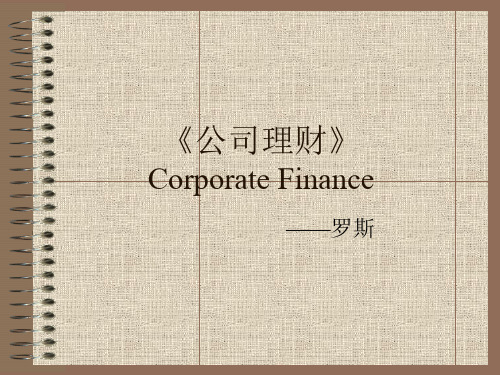
Treasurer
Controller
Cash Manager
Capital Expenditures
Credit Manager
Tax Manager
Financial Accounting
Cost Accounting
Financial Planning
Data Processing
1.1 什么是公司理财
法律责任(Liability) 存续期(Continuity)
有限责任 无限存续期
税收(Taxation)
对股东双重征税(公司所得 税和个人所得税)
个人所得税
资金筹集
易于筹集资金
难于筹集资金
1.2 公司制企业
1.2.3 公司制
对于解决所面临的筹集大规模资金的问题来说,公司制是一种标准 的方式。
1.3 公司制企业的目标
1.5 金融市场
1.5.1 一级市场
政府或公司首次发行证券形成一级市场。 公开发行(公募) 大部分公开发行的债券和股票由投资银行承销而进入市场。 在美国公开发行债券和股票必须在美国证券交易委员会注册登 记。 私下募集(私募): 私下通过谈判将债券和股票出售给一些大型金融机构(如保险 公司、共同基金)。 私募不需要在证券交易委员会注册登记。
1.4 代理问题和公司的控制
1.4.3 股东能控制管理者的行为吗?
股东可以使用以下几种措施将管理者与股东的利益联系在一起: 1)股东投票选举董事会成员,董事会成员选择管理者。 2)通过与管理者签定收入报酬计划,激励管理者追求股东的 目标。 3)如果因为管理不善使得企业股票价格大幅下降,企业可能 遭受其他股东集团、公司或个人收购,这种担心将促使管理者采取使股 东利益(股票价值)最大化的行动。 4)经理市场的竞争也可以促使管理者在经营中以股东利益为 重。能成功执行股东目标的管理者可能得到提拔,可以要求更高的薪水; 否者,他们将被解雇。 有效的证据和理论证明,股东可以控制公司;公司的目标是追求股 东价值最大化。 但是,在某些时候公司追求管理者的目标而使股东付出代价。
图表齐全的罗斯《公司理财》第三章财务报表分析和财务
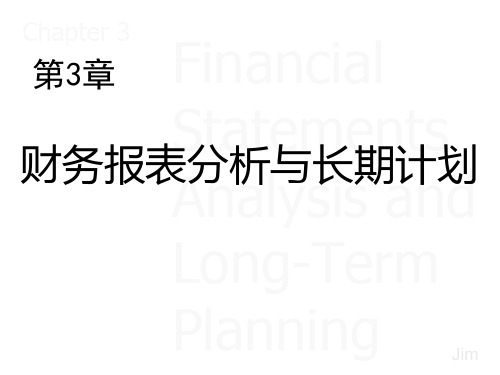
1989
3.4%
0.71
4.95 12.1%
1993
1.8%
0.73
33.62 44.1%
注意:此例中,ROE的戏剧性提升几 乎全部来自于影响权益乘数的会计处 理,根本不能代表财务业绩的提升。
由于养老金负债的会计处理, 1992年的账面权益价值几乎 在一夜之间被核销殆尽。因此,
权益乘数大幅增加。
杜邦分析的扩展
六、外部融资与增长
• 本节之前,设定增长率,讨论财务政策 (外部融资需要量EFN)。
• 本节,设定财务政策,讨论可达成的增长 率。
EFN与增长率相关联。若其他情况不变,销 售或资产增长率越高,EFN越大。
(一)EFN与增长
P51 权益负债比为1
预计销售额由 500美元增加 到600美元, 增长率为20%
(横向比较)
3.
(运用行业分类代码SIC寻找类似公司,
P42/表3-7)
注意:行业分类表(SIC)还不够完善,运用SIC只是寻找近似同 类的公司,不可盲目运用。(例:沃尔玛与内曼-马库斯比较)
所有公司 汇总的历 史信息
按销售额分组 的不同公司
中位数
应收账款 周转期
有效计算样 本数(实际 支付了利息 的公司数量)
这三个比率中,只要给定其中的一个,就能立即算 出另外两个
(二)长期偿债能力指标
利息倍数= EBIT(息前税前利润) 利息
衡量公司负担利息 的能力如何
现金对利息的保障倍数= EBIT 折旧 利息
= EBITD(息前税前折旧前利润) 利息
计算EBIT时,非现金项目折旧已被减去,因而EBIT并不能真 正度量可用于支付利息的现金有多少。故加入折旧的指标通
公司理财

Westerfield Jordan
15 © Lizzie., 2011
Corporate Finance
Ross
Fundamentals of
和法人治理结构。
. .
优点和缺点比较
9th Edition
个人业主制 创立和费用 简单/低 产权转让、资金筹集 简单/难 控制权 集中 责任 无限 生命期 有限 税收 个人所得税
Westerfield Jordan
14 © Lizzie., 2011
Corporate Finance
Ross
Fundamentals of
. .
企业组织形式
9th Edition
单一业主制:1个人经营管理 合伙制:若干人经营管理,一般合伙人 负无限责任,有限合伙人以其出资负有限责任 一般合伙制:参加人全是一般合伙人。 有限合伙制:参加人至少有1个为一般合伙人。 公司制:公司是独立法人,实行法人财产制度
短期
流动资产 负债
长期
负债 固定资产 1 有形的 2 无形的
应选择什么样 的长期投资项 目?
所有者 权益
. .
资本结构决策
9th Edition
Westerfield Jordan
6 © Lizzie., 2011
Corporate Finance
Ross
Fundamentals of
短期
流动资产 负债
资产总价值
投资者拥有的总价值 短期负债
Fundamentals of
流动资产 长期负债 固定资产 1有形的 所有者权益
. .
2无形的
资本预算决策
9th Edition
Westerfield Jordan
- 1、下载文档前请自行甄别文档内容的完整性,平台不提供额外的编辑、内容补充、找答案等附加服务。
- 2、"仅部分预览"的文档,不可在线预览部分如存在完整性等问题,可反馈申请退款(可完整预览的文档不适用该条件!)。
- 3、如文档侵犯您的权益,请联系客服反馈,我们会尽快为您处理(人工客服工作时间:9:00-18:30)。
Key Concepts and Skills
Know how to standardize financial statements for comparison purposes
Know how to compute and interpret important financial ratios
Chapter 3
Financial Statements Analysis and Long-Term Planning
McGraw-Hill/Irwin
Copyright © 2010 by the McGraw-Hill Companies, Inc. All rights reserved.
Compute all line items as a percent of sales
Standardized statements make it easier to compare financial information, particularly as the company grows.
365 / 3.2 = 114 days
3-9
Computing Receivables Ratios
Receivables Turnover = Sales / Accounts Receivable
2311 / 188 = 12.3 times
Days’ Sales in Receivables = 365 / Receivables Turnover
Models
3-2
3.1 Financial Statements Analysis
Common-Size Balance Sheets
Compute all accounts as a percent of total assets
Common-Size Income Statements
3-4
Categories of Financial Ratios
Short-term solvency or liquidity ratios Long-term solvency or financial leverage
ratios Asset management or turnover ratios Profitability ratios Market value ratios
3-5
Computing Liquidity Ratios
Current Ratio = CA / CL
708 / 540 = 1.31 times
Quick Ratio = (CA – Inventory) / CL
(708 - 422) / 540 = .53 times
Cash Ratio = Cash / CL
Be able to develop a financial plan using the percentage of sales approach
Understand how capital structure and dividend policies affect a firm’s ability to grow
They are also useful for comparing companies of different sizes, particularly within the same industry.
3-3
3.2 Ratio Analysis
Ratios also allow for better comparison through time or between companies.
Equity Multiplier = TA / TE = 1 + D/E
1 + .385 = 1.385
3-7
Computing Coverage Ratios
Times Interest Earned = EBIT / Interest
691 / 141 = 4.9 times
Cash Coverage = (EBIT + Depreciation + Aห้องสมุดไป่ตู้ortization) / Interest
3-1
Chapter Outline
3.1 Financial Statements Analysis 3.2 Ratio Analysis 3.3 The Du Pont Identity 3.4 Financial Models 3.5 External Financing and Growth 3.6 Some Caveats Regarding Financial Planning
365 / 12.3 = 30 days
As we look at each ratio, ask yourself:
How is the ratio computed? What is the ratio trying to measure and why? What is the unit of measurement? What does the value indicate? How can we improve the company’s ratio?
98 / 540 = .18 times
3-6
Computing Leverage Ratios
Total Debt Ratio = (TA – TE) / TA
(3588 - 2591) / 3588 = 28%
Debt/Equity = TD / TE
(3588 – 2591) / 2591 = 38.5%
(691 + 276) / 141 = 6.9 times
3-8
Computing Inventory Ratios
Inventory Turnover = Cost of Goods Sold / Inventory
1344 / 422 = 3.2 times
Days’ Sales in Inventory = 365 / Inventory Turnover
